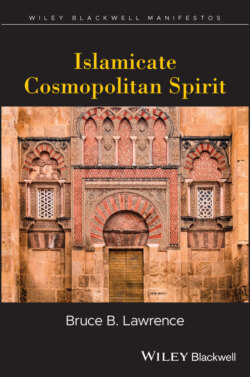Читать книгу Islamicate Cosmopolitan Spirit - Bruce B. Lawrence - Страница 16
1 Tracing Islamicate Cosmopolitan Spirit Across Time and Space
ОглавлениеTo look at Islamicate civilization is to face the choice of where and when to look but it also requires one to invoke fuzzy or barzakh logic at the outset. There is no great divide between East and West or between Islam and its political–religious rivals, whether in the premodern or the modern world. Many are the historians who have labored to point out that civilizational study is predicated on “gray” not black and white visions of the past, and multiple, local understandings of civilizational actors, events, institutions, and legacies.
In short, cosmopolitan studies, like civilizational studies with which it is allied and on which it must be modeled, requires decentering the West and reappropriating the “rest” for a deeper, truer sense of what is genuinely world history.
In that quest for a revisionist world history—or what one scholar has framed “a world history worthy of the name”1—Marshall Hodgson occupies a special place. His legacy has to be reviewed to understand how one builds on the edifice he proposed in order to trace the enduring influence of Islamicate Cosmopolitan Spirit (ICS).
Hodgson begins not with the premodern but with the modern world. He asks of himself the tough question all of us must ask: not what is Western but what is the force of “Western” as a descriptor in the numerous theoretical studies on modernity? At the same time, he launches a thorough, all-out attack on Weberian notions of calculative rationalism. He challenges Weberian assumptions in offering a prognosis for transformation on a different calculus than others have made. As a world historian,2 the arguments he makes for transformation apply to a broad spectrum of humankind. Religion looms as the catalyst for hopeful change, and for genuine transformation, in the future, but does religion assist or impede the modernization process?
I contest the assumption that only modernization finally works, and that religions must be judged good or bad by how congruent or dissonant they are with forces, structures, and goals of modernization. I prefer to stand this question on its head, suggesting that modernization is neither monolithic nor inevitable. It is not monolithic because it did not impact on all parts of Euro-America with equal success. Nor is it inevitable since it was a concatenation of circumstances rather than any single cluster of ideal traits or the convergence of such traits with technical discoveries, all of which produced what Hodgson termed the Great Western Transmutation.
The Great Western Transmutation overlooked the key forces that had forged all the great civilizations of premodern history: individual initiative and cultural creativity. They remain the twin ideals for Hodgson that caused him to describe the most recent axial shift as the Great Western Transmutation. Great Western Transmutation invokes Jaspers’ notion of axial shift covering not only centuries but millennia of historical variation, while also affirming Weber’s insight into the distinctive character of modern European technicalism. But at the same time, Hodgson wanted to acknowledge the social achievements and cultural norms of non-Western societies, highlighting what they had deemed to be both creative and productive. And so, in his major essay on the ambiguous character of modernity, published over 50 years ago (1967), Hodgson drew attention not to Euro-American global dominance but to the downside of this dominance for the dominated or marginalized. Noting that “gradual diffusions had maintained parity among Afro-Eurasian citied societies,” he lamented that “the Western Transmutation, once it got well under way, could neither be paralleled independently nor be borrowed wholesale. Yet it could not, in most cases, be escaped. The millennial parity of social power broke down, with results that were disastrous almost everywhere.”3
